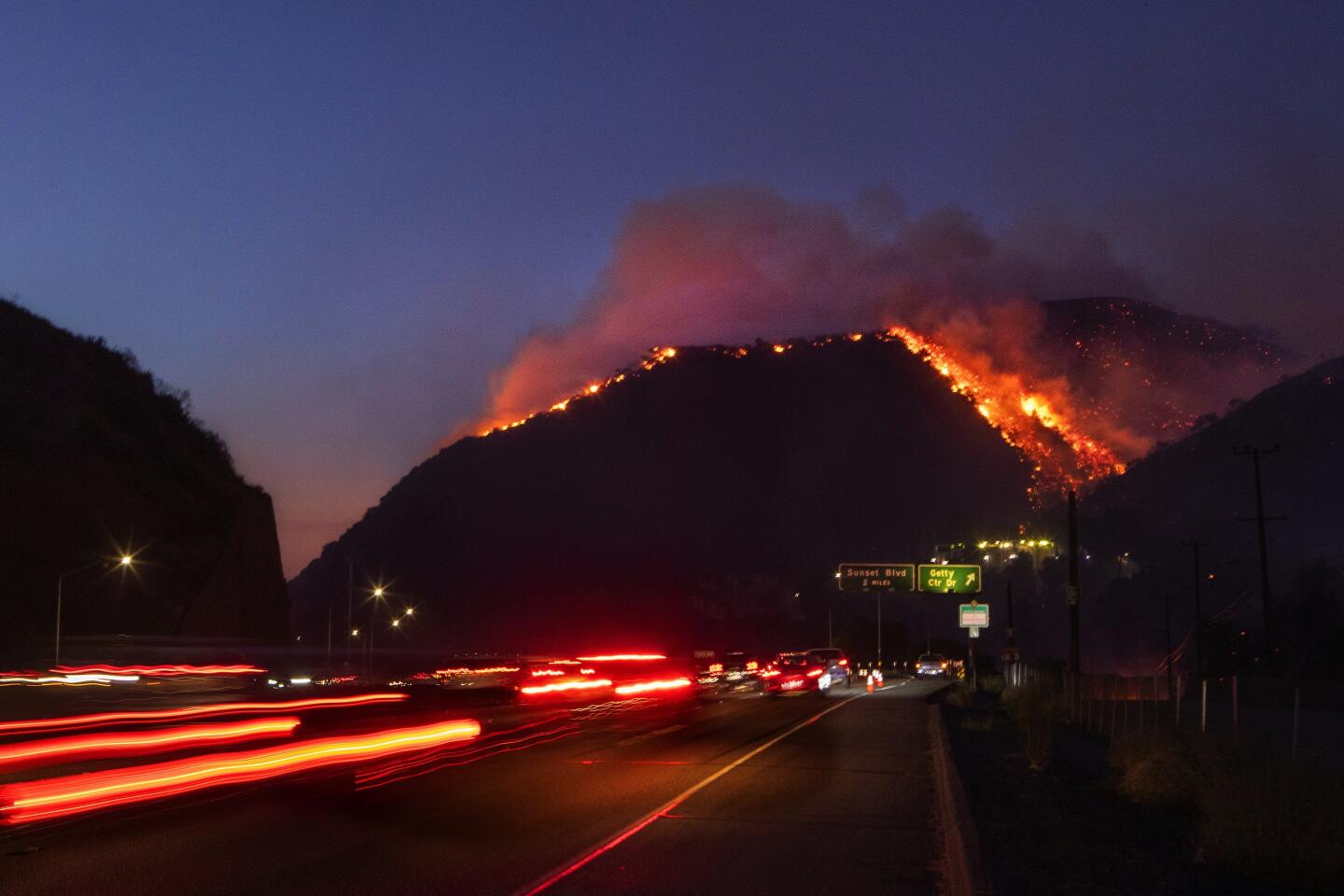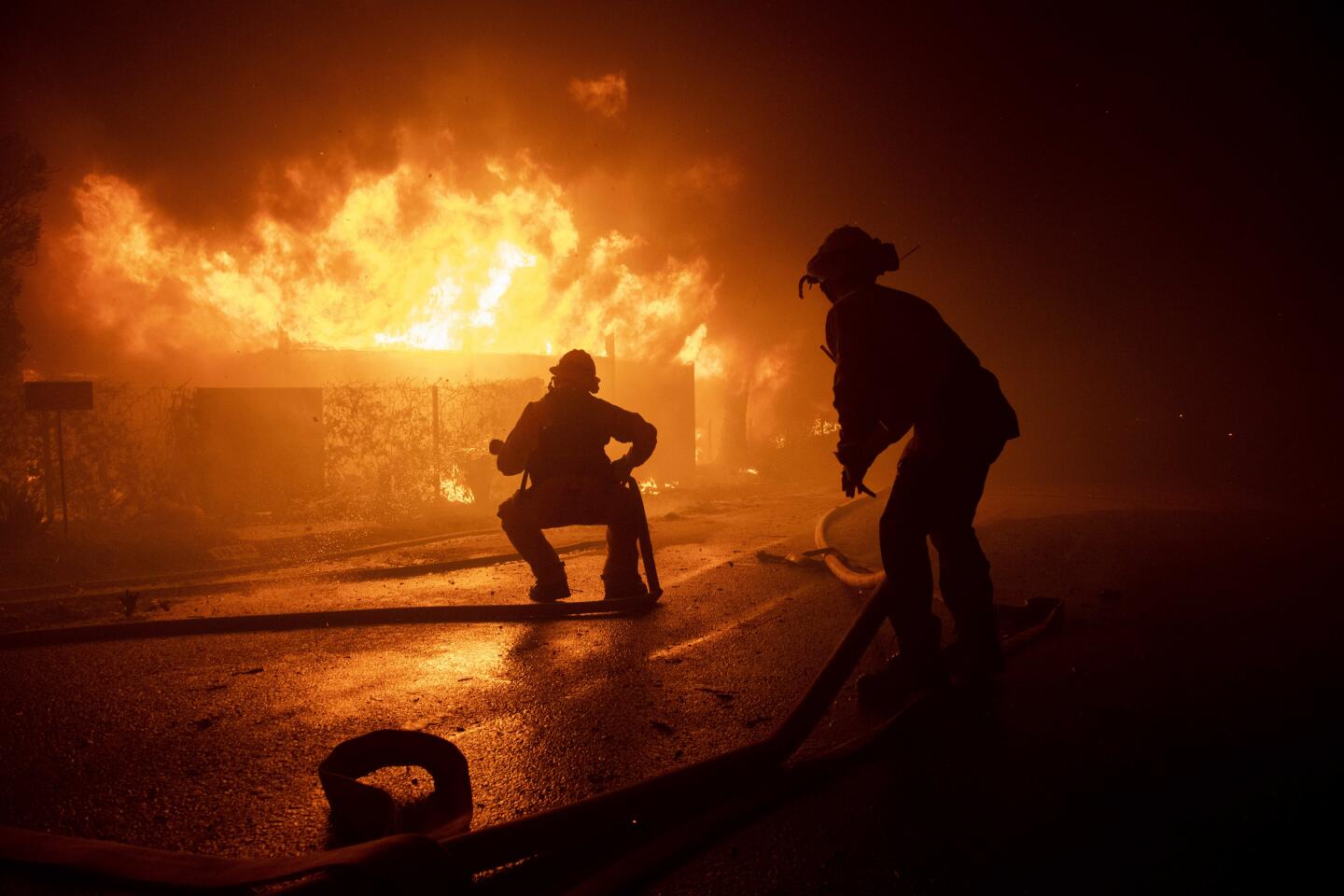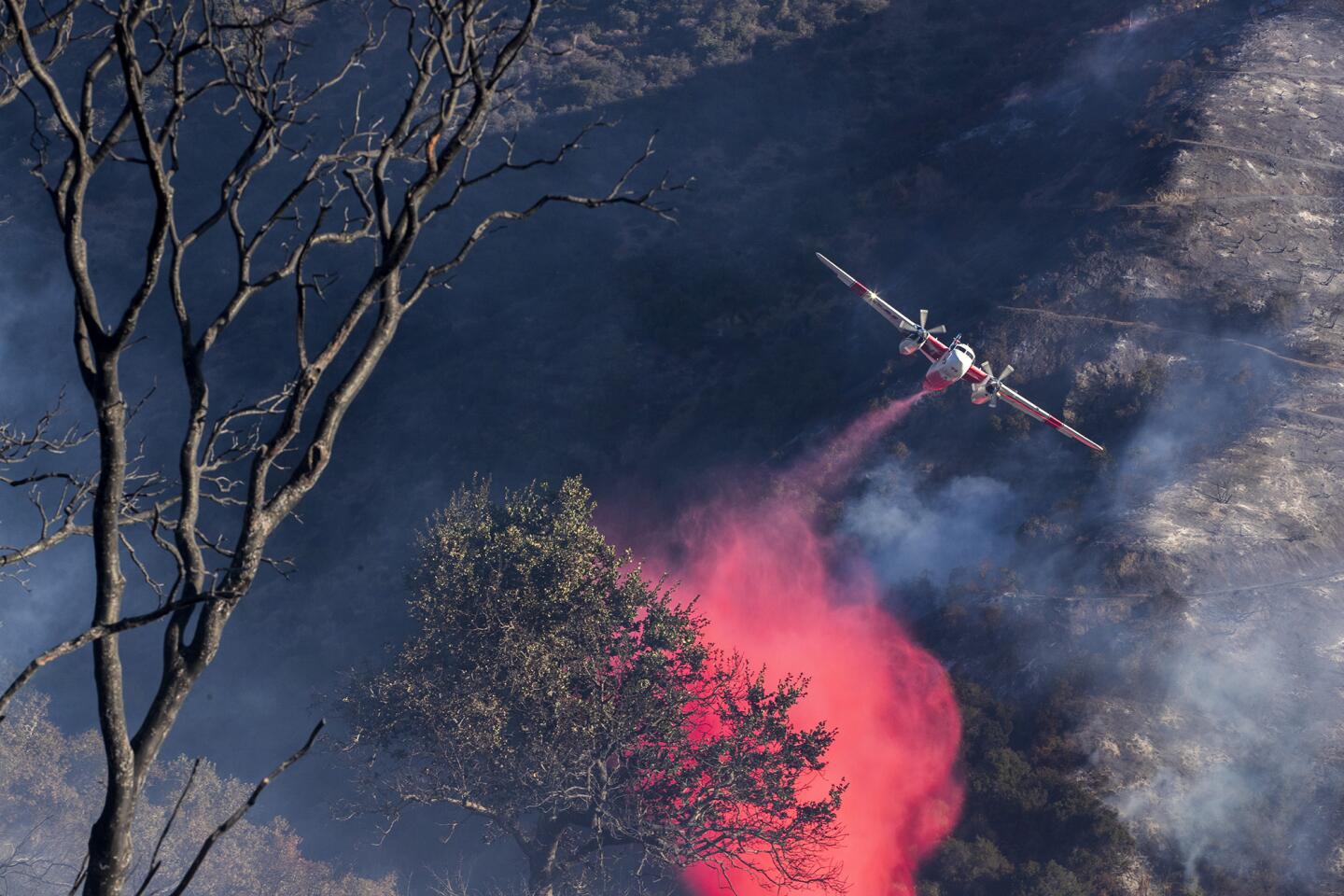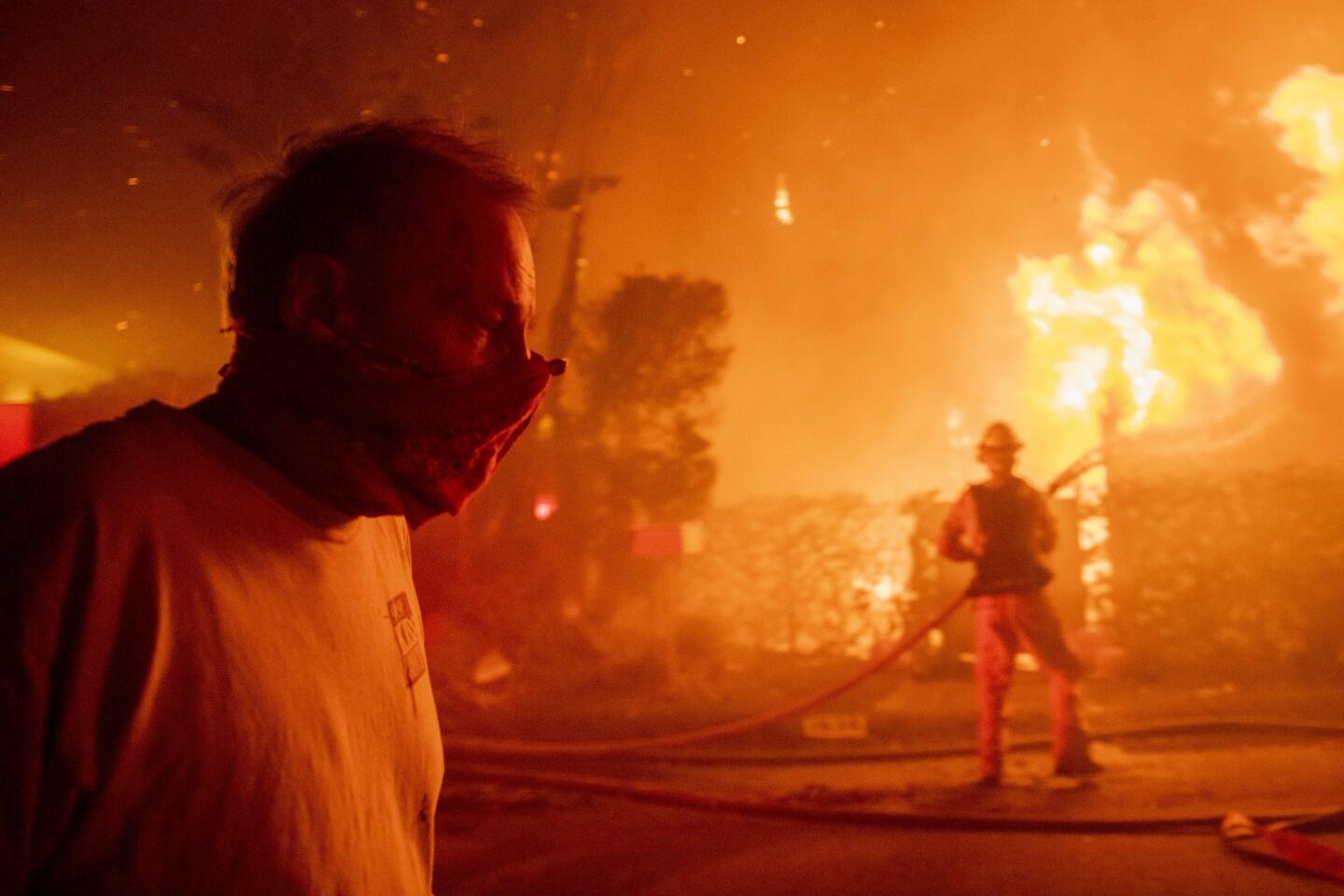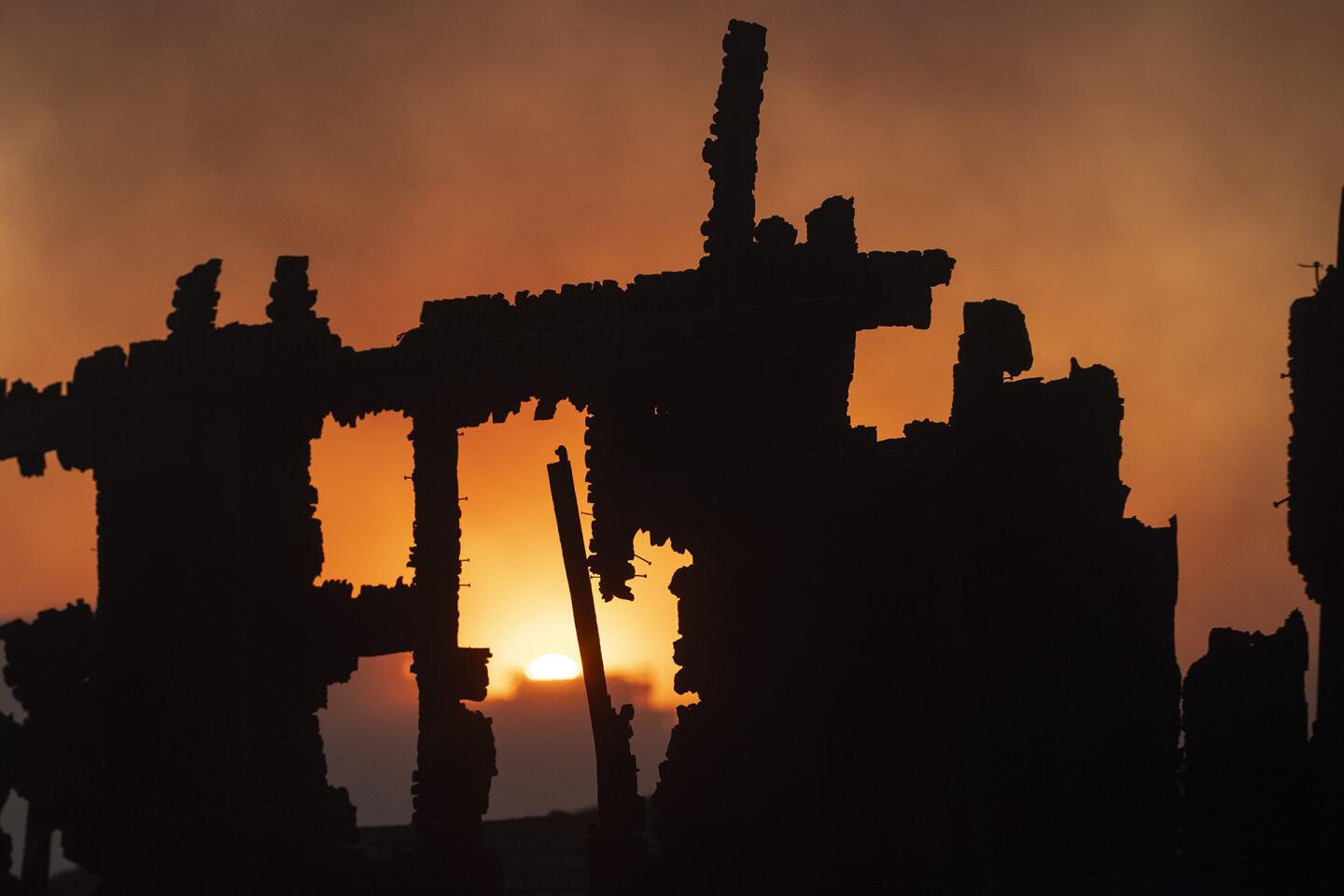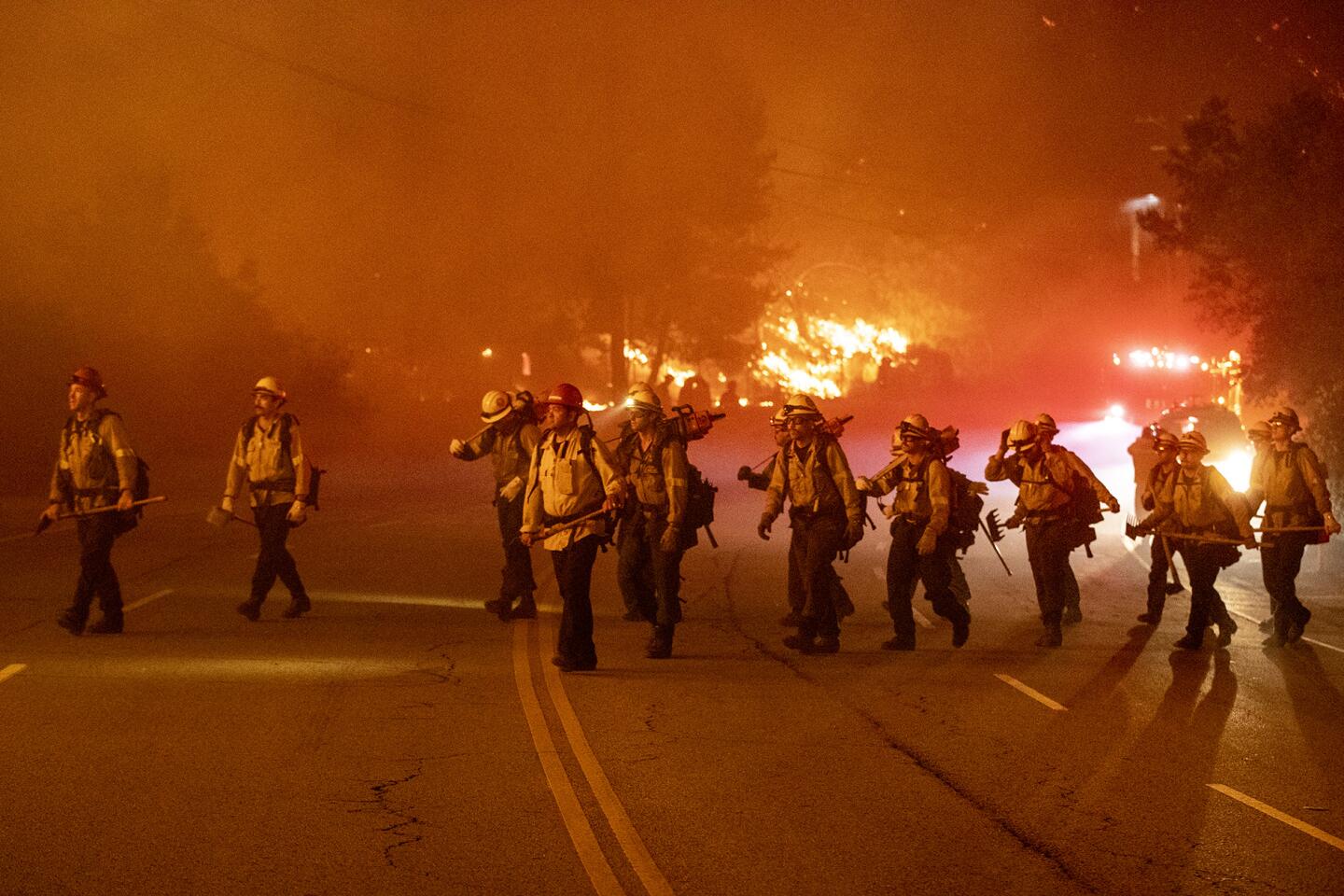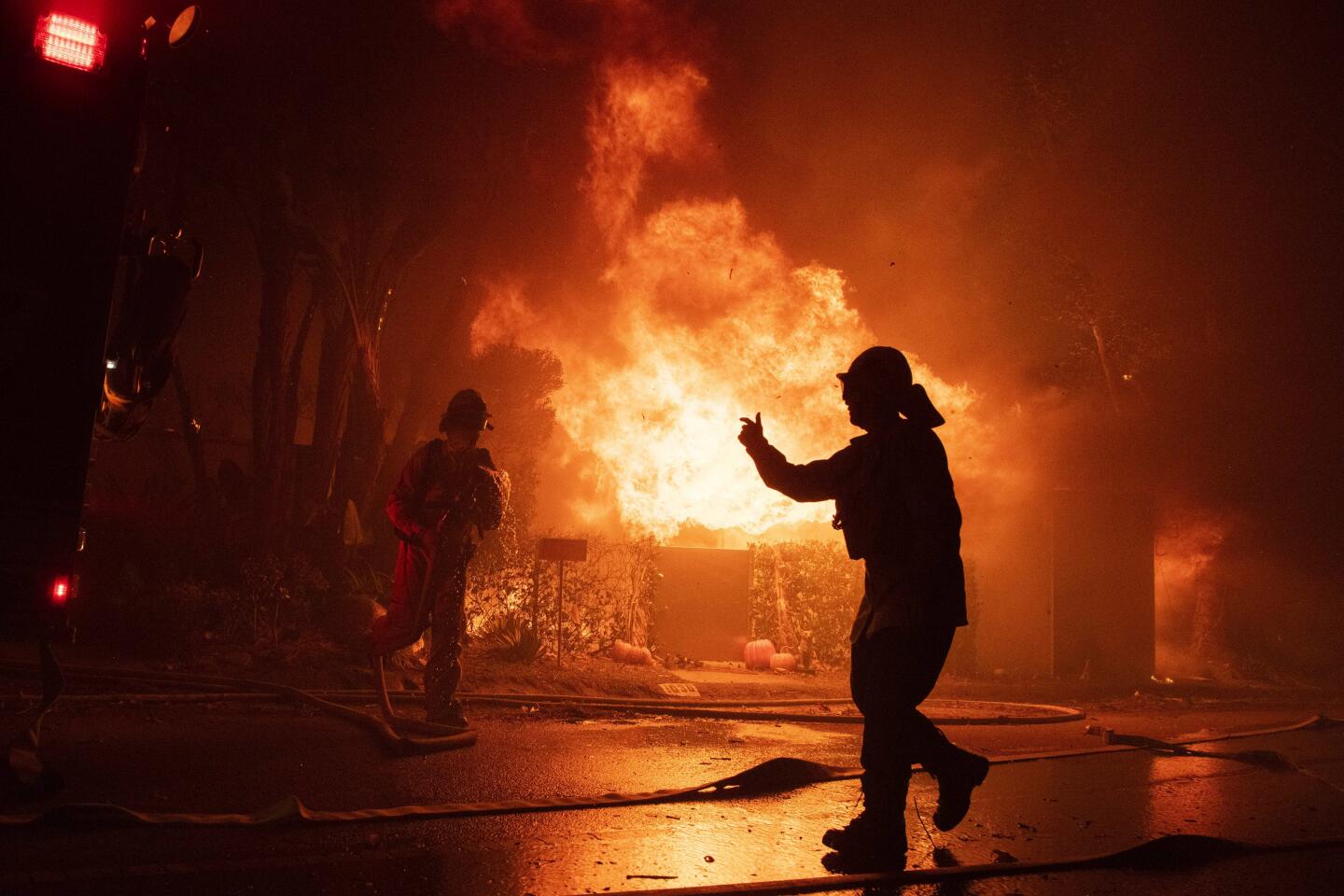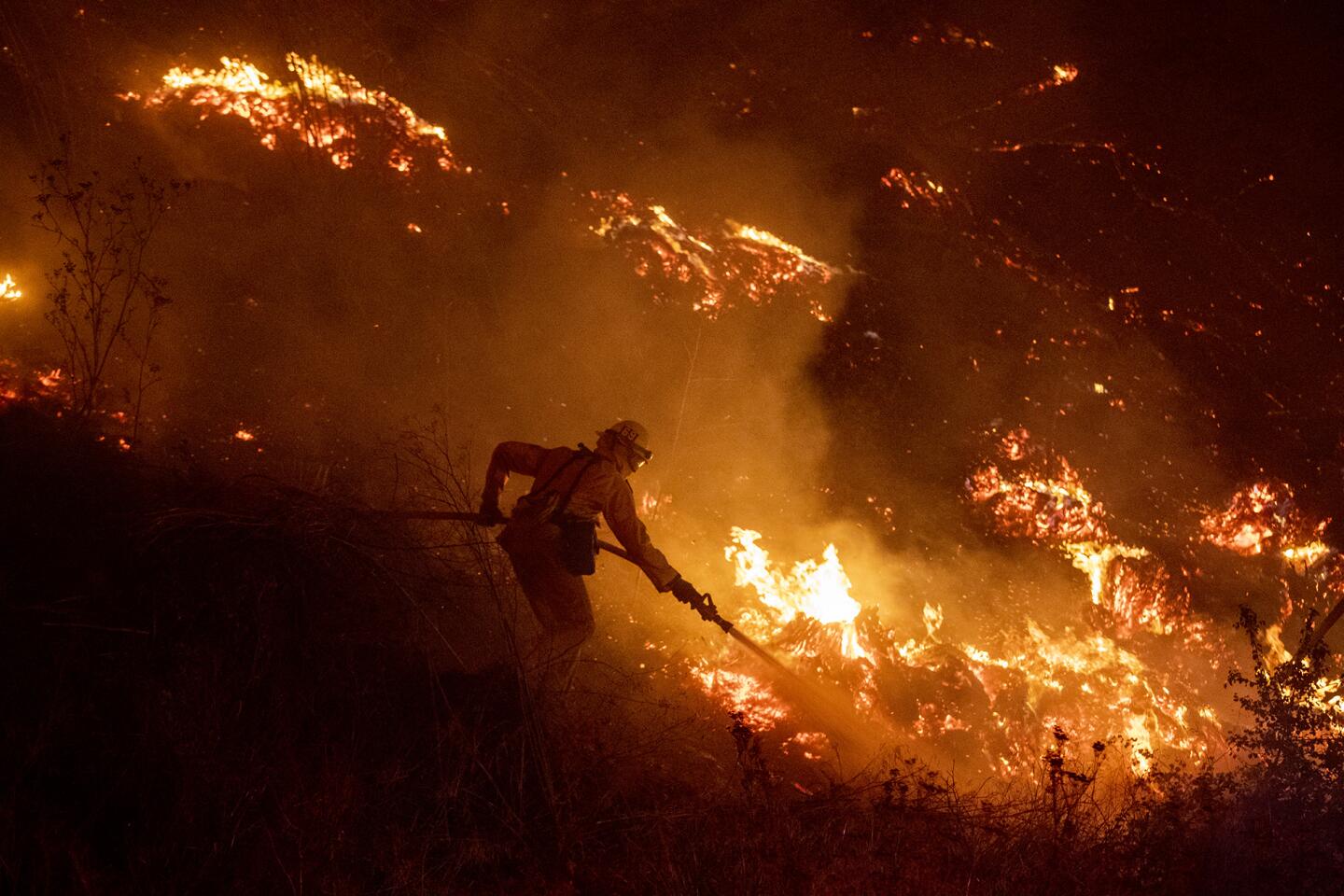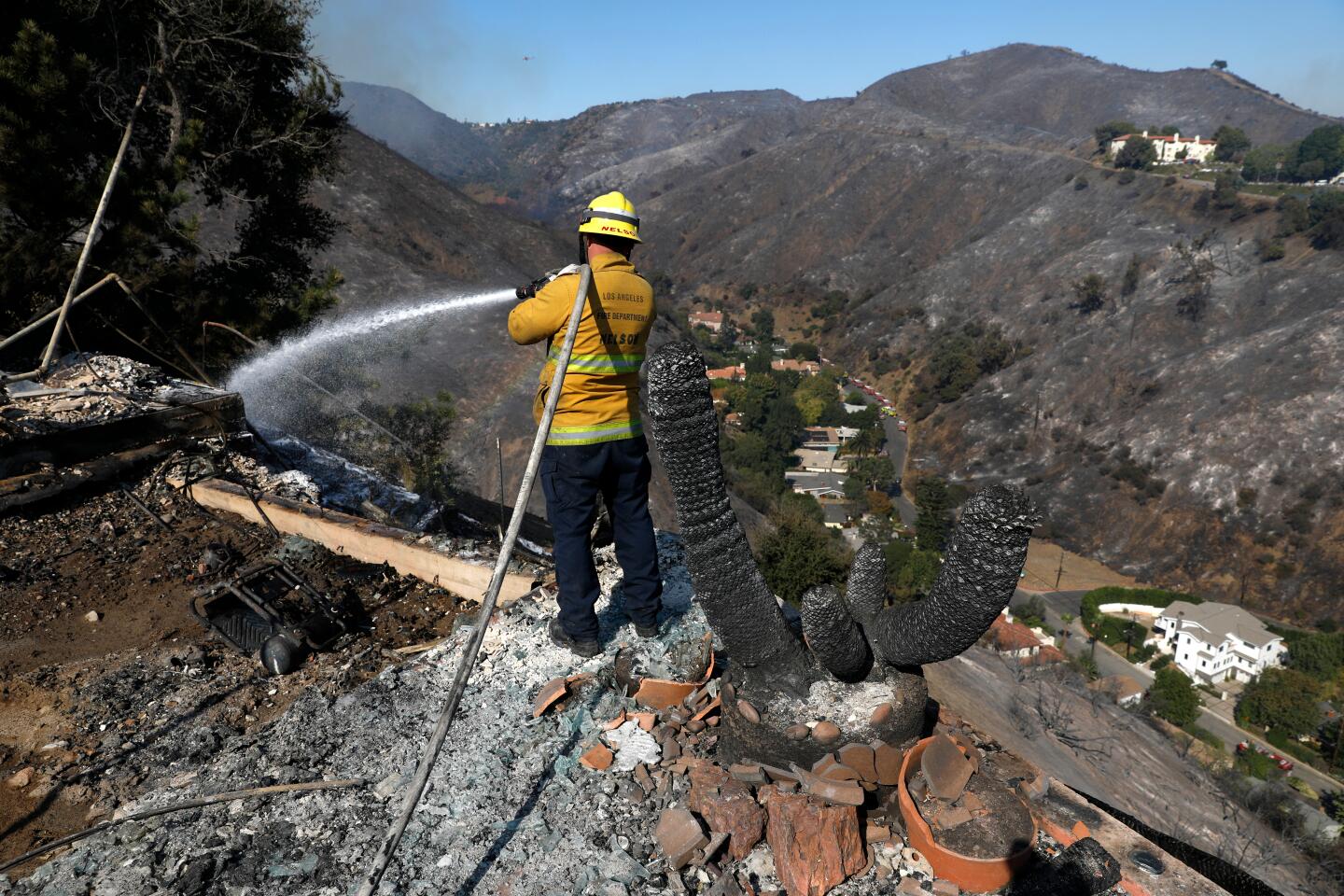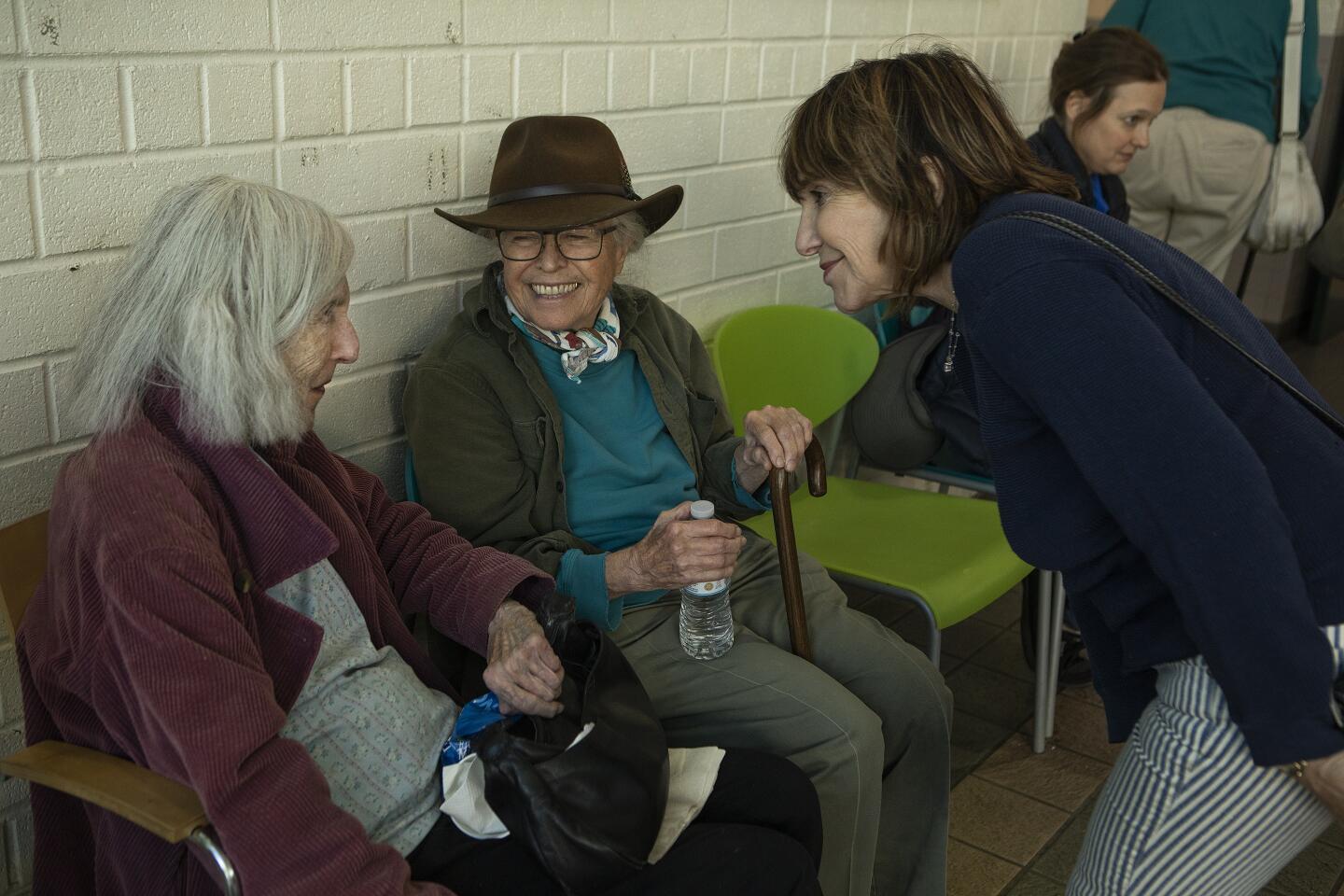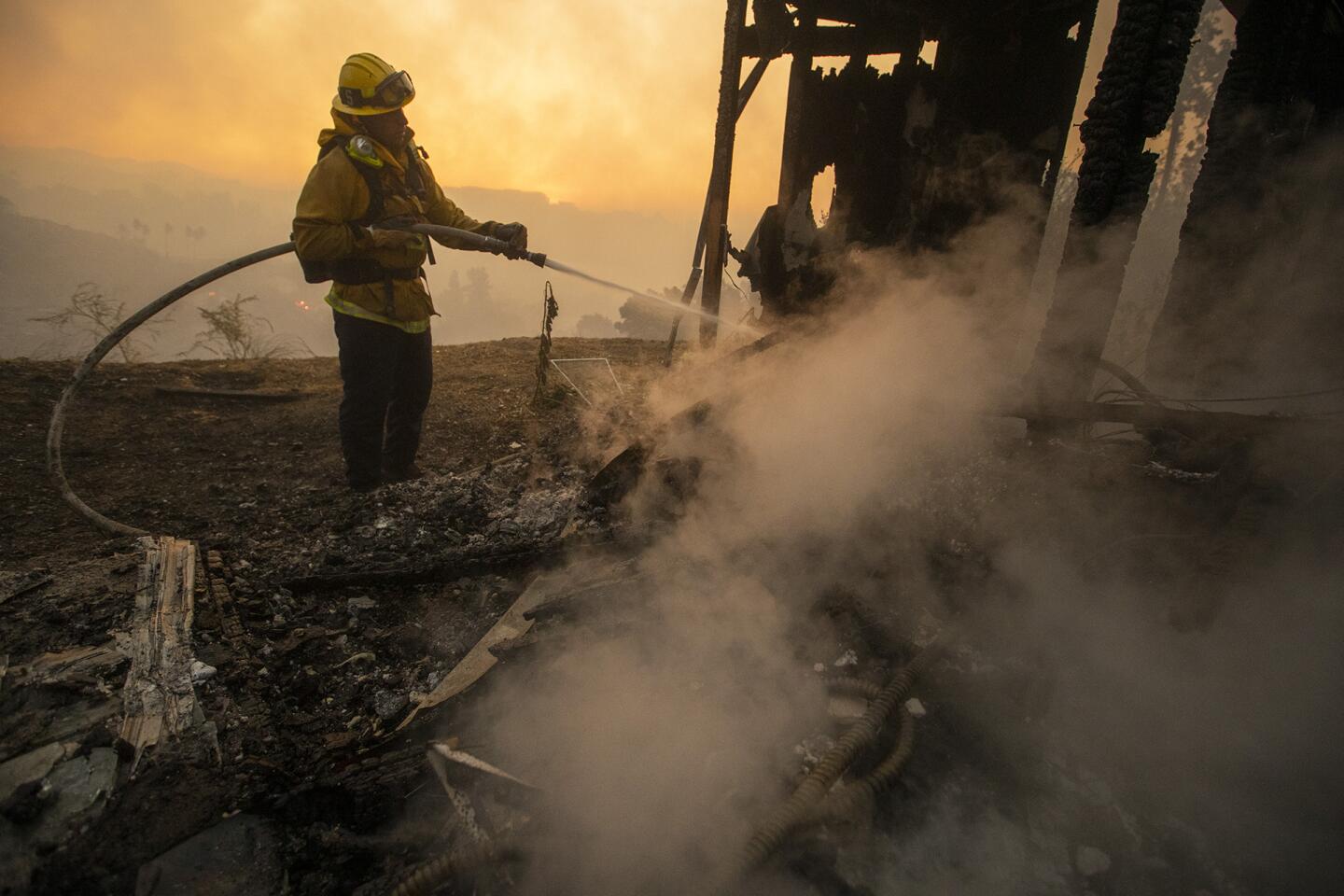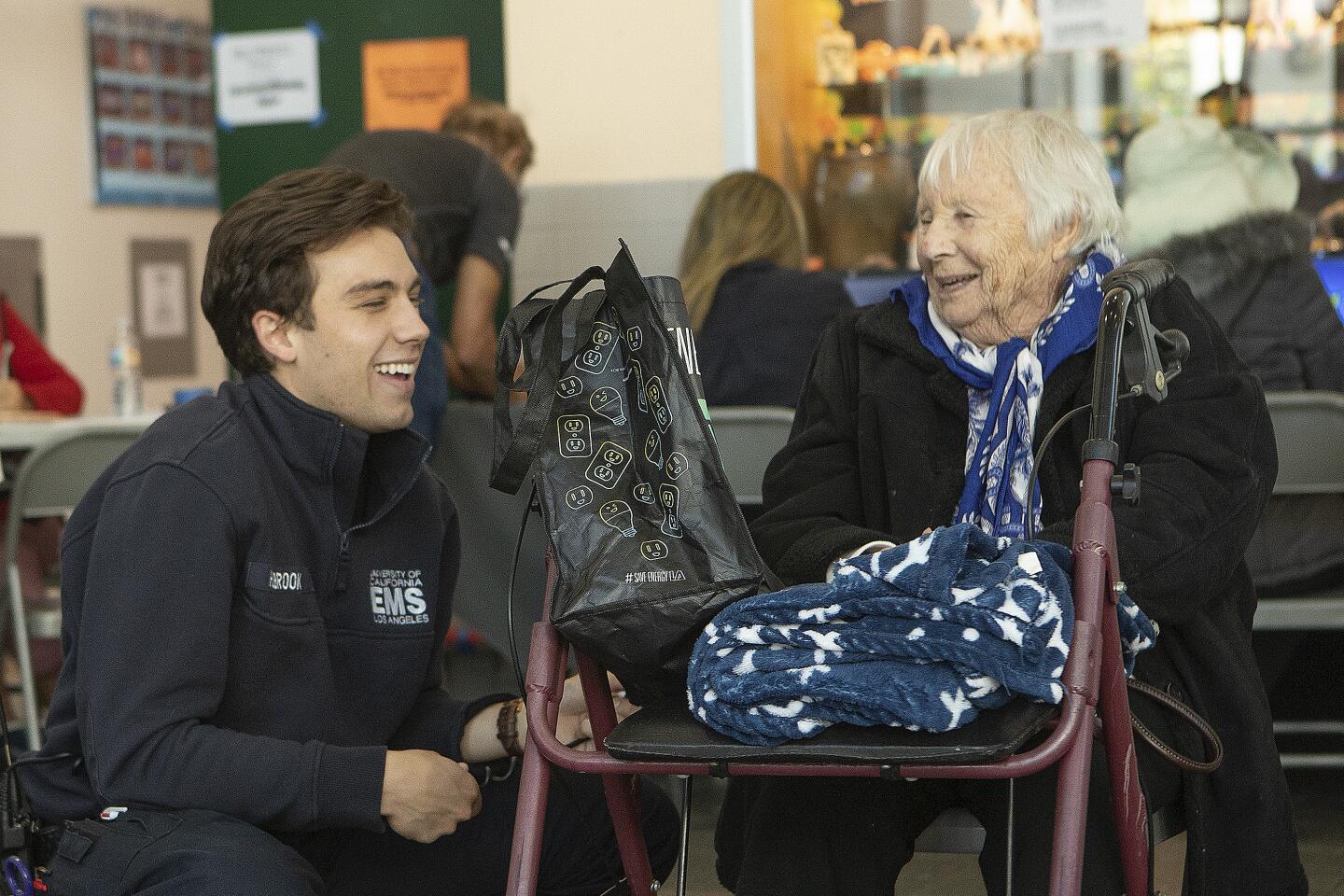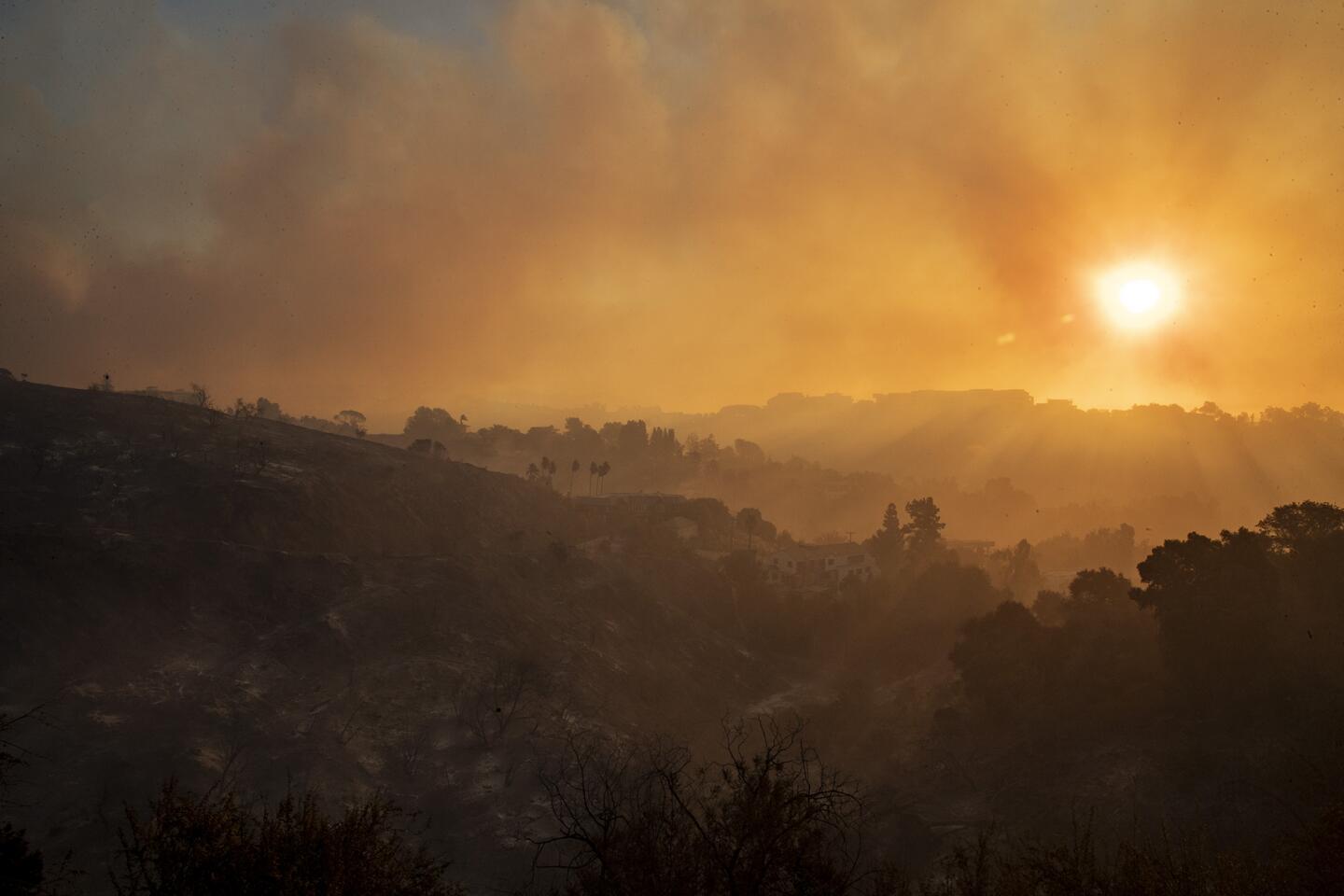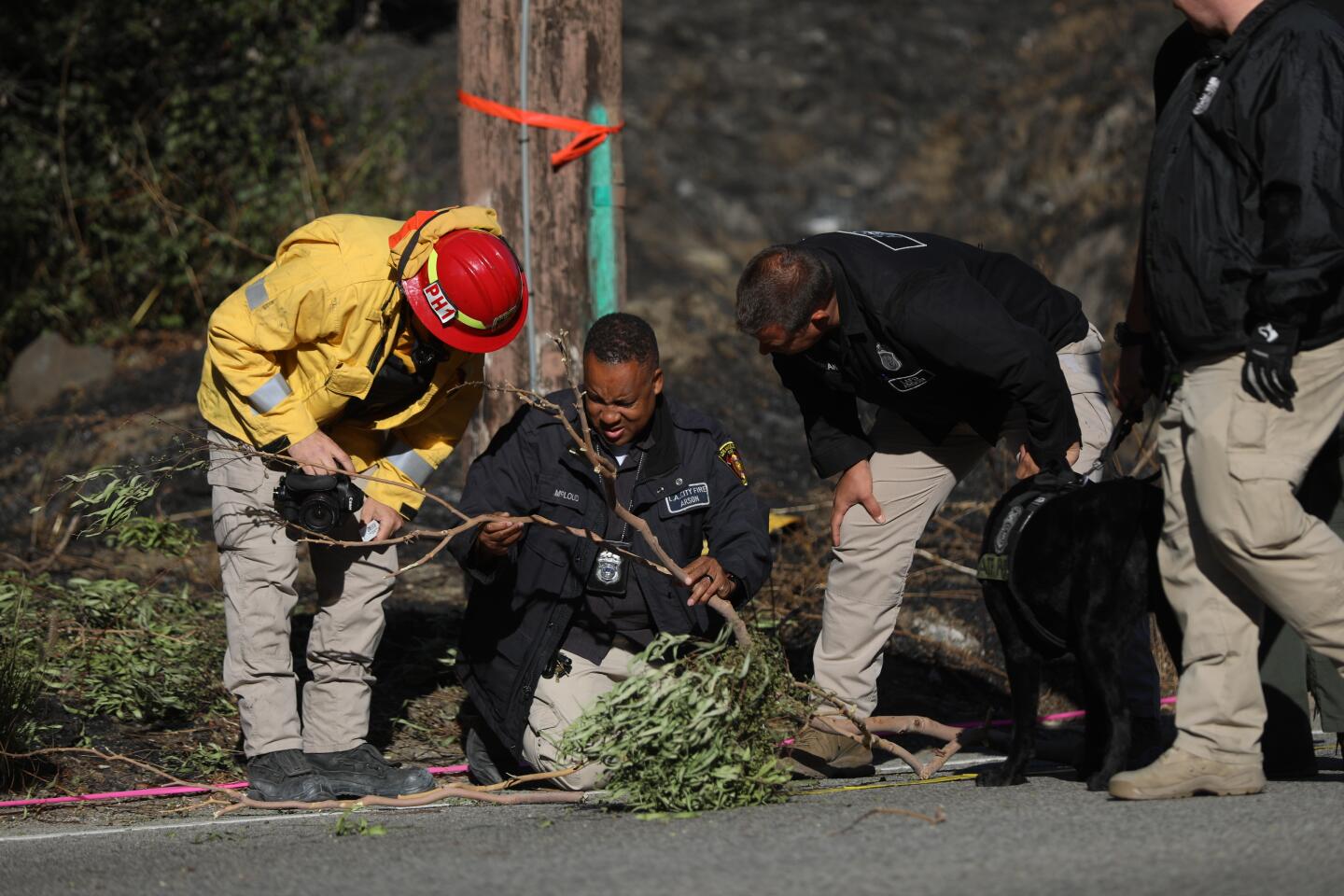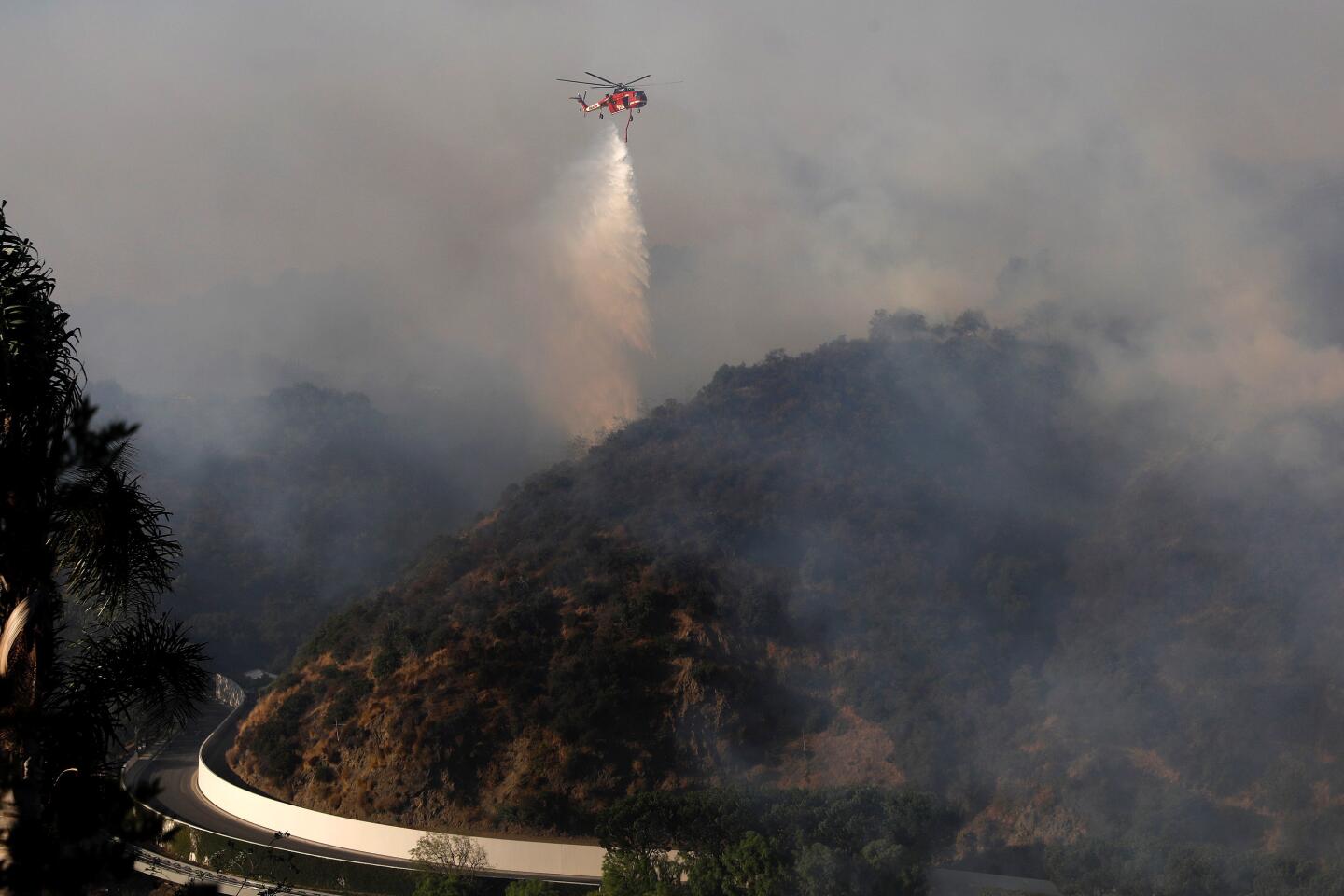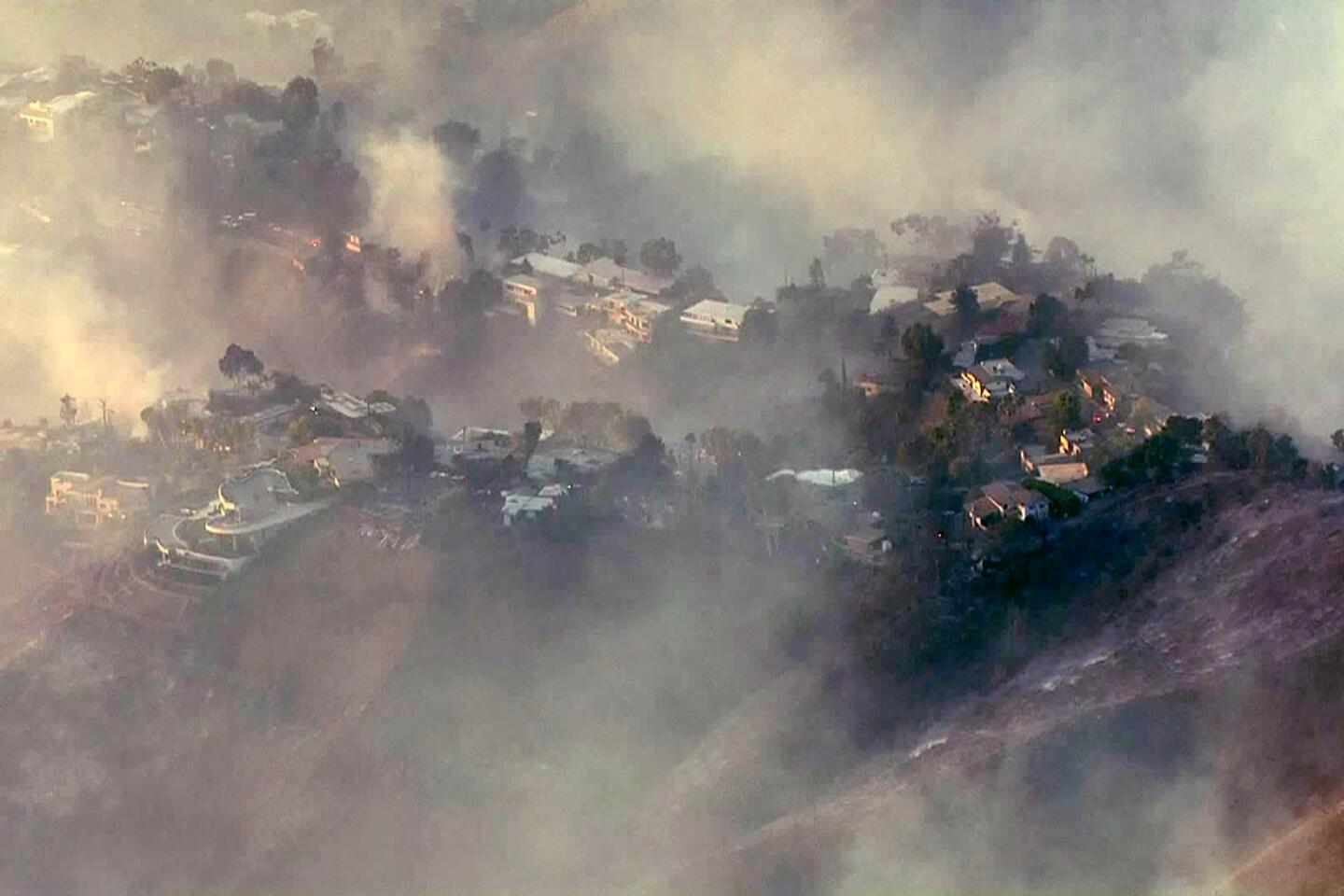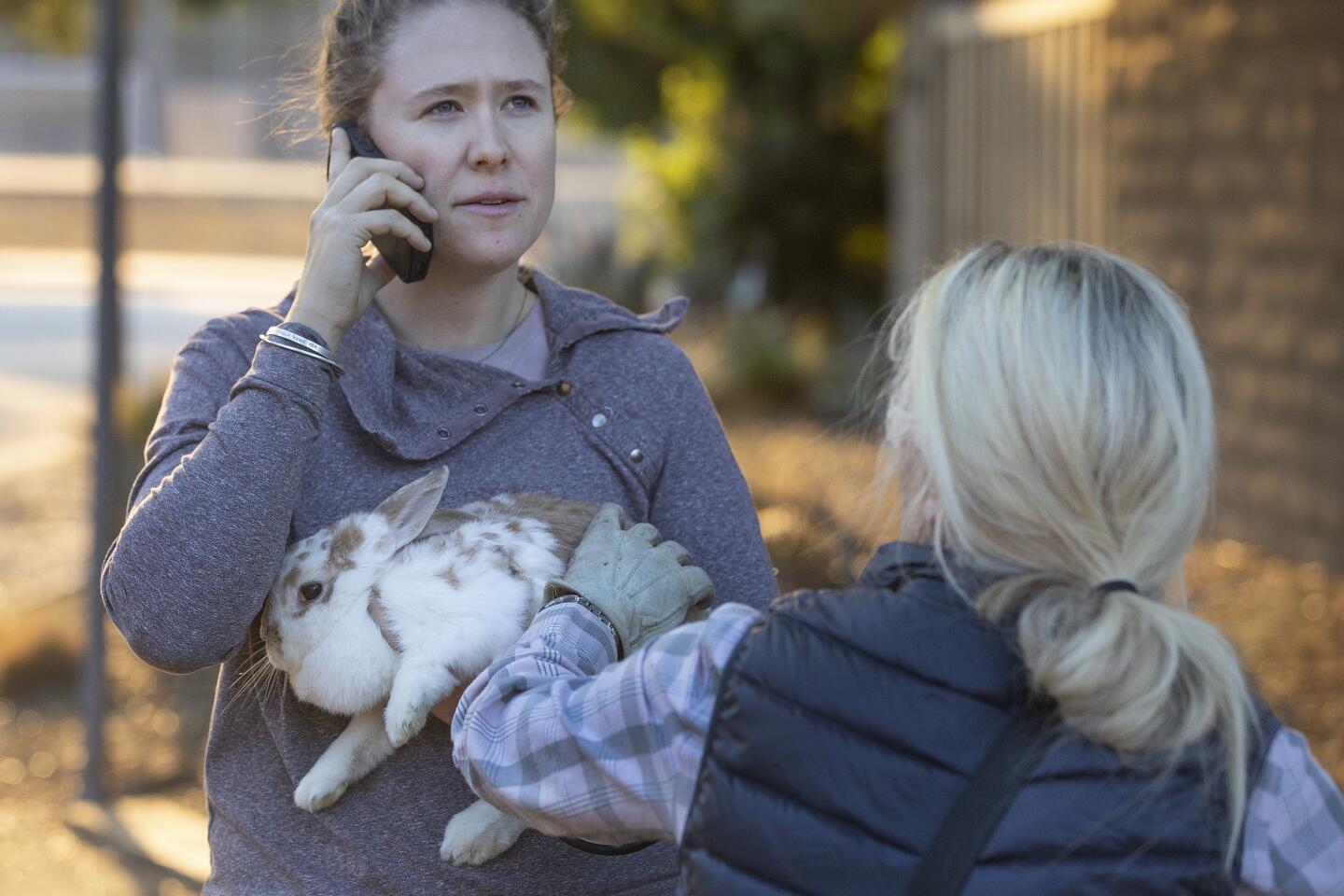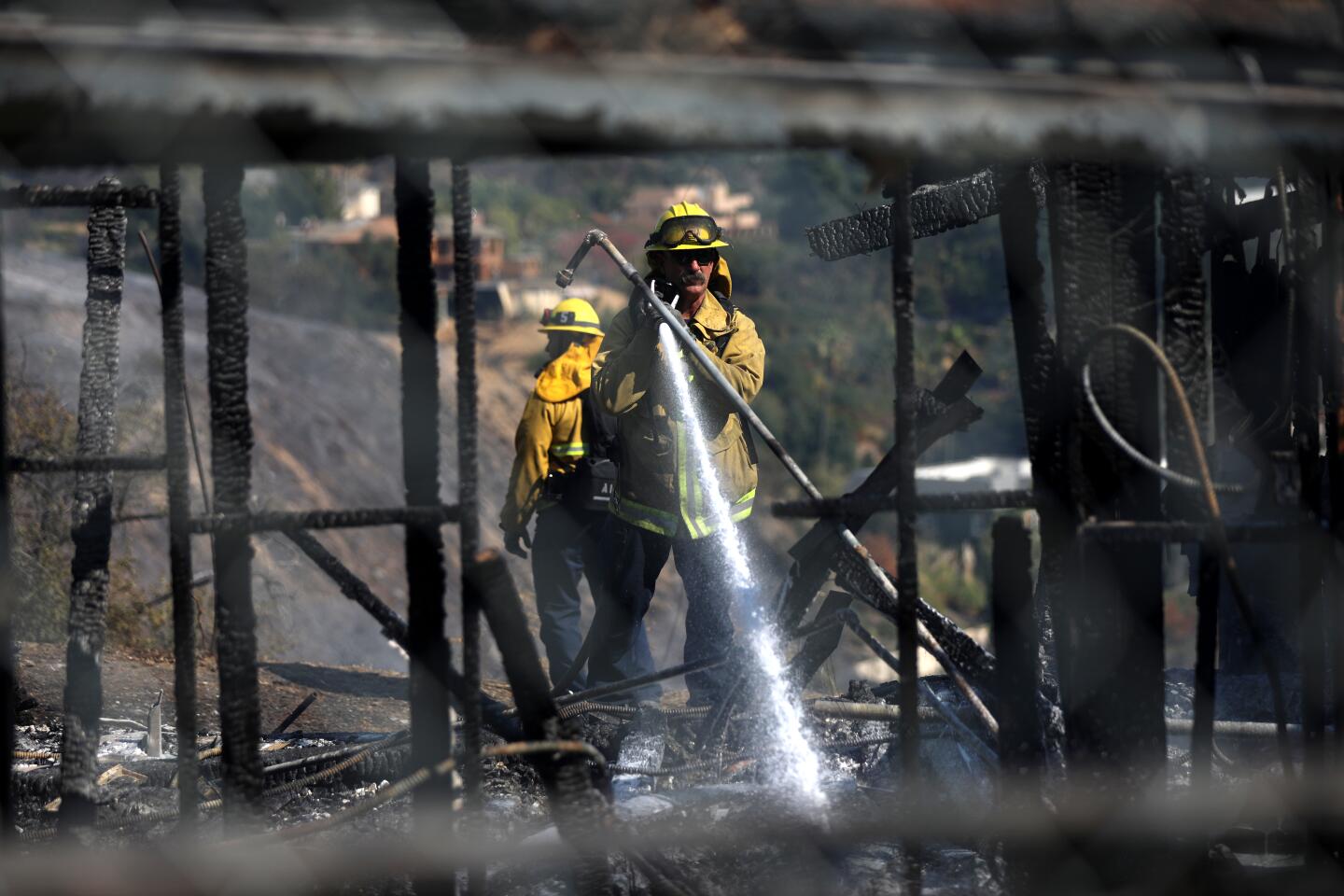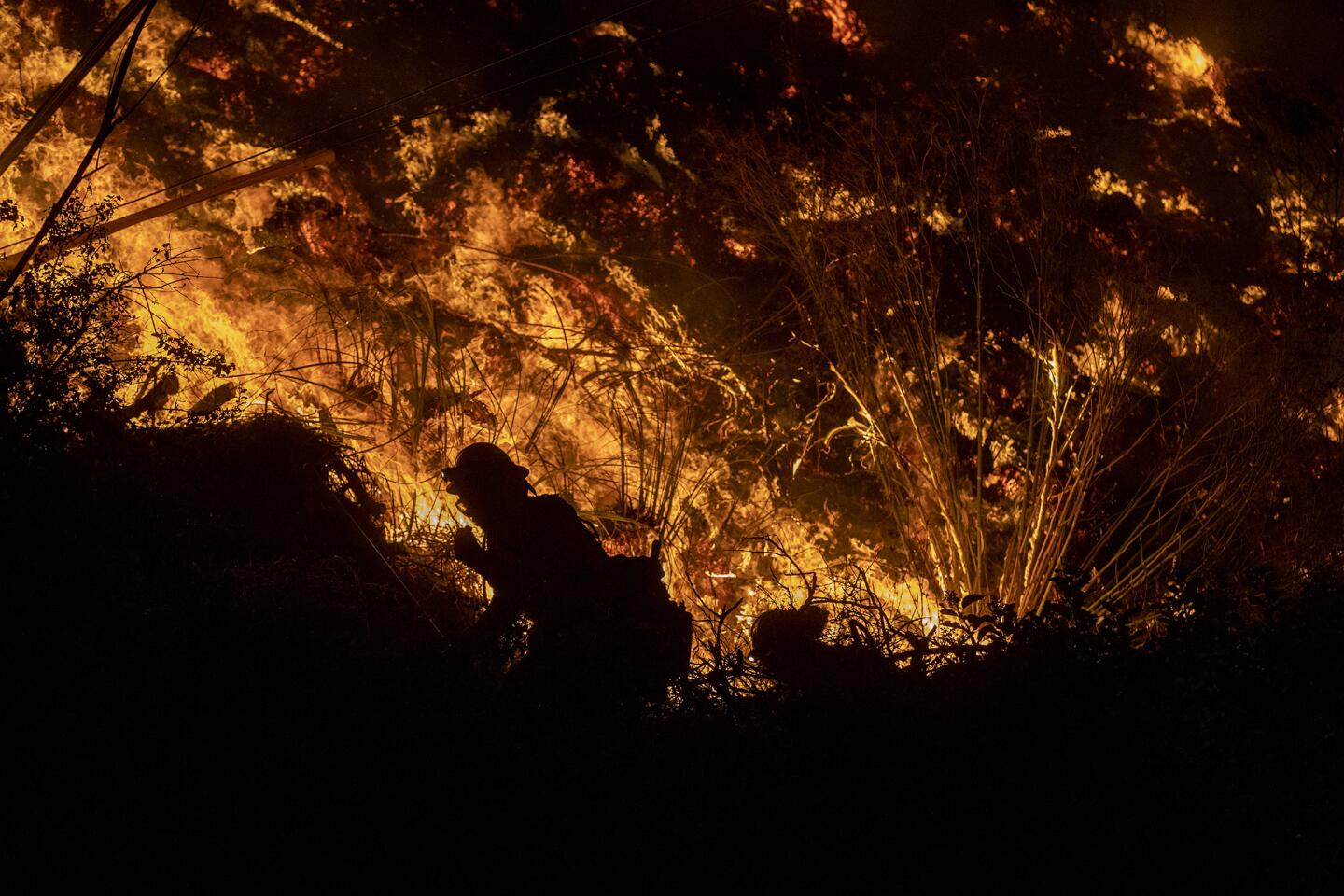Getty fire off 405 Freeway in L.A. destroys several homes; thousands flee

- Share via
A wind-driven brush fire chewed through hillside communities on the west side of Los Angeles on Monday, burning homes and prompting widespread evacuations.
The Getty fire broke out shortly after 1:30 a.m. along the 405 Freeway near the Getty Center and spread to the south and west, rapidly burning more than 600 acres and sending people fleeing from their homes in the dark. About 10,000 structures have been placed under mandatory evacuation orders.
Los Angeles Fire Department Chief Ralph Terrazas said that, despite firefighters’ efforts, at least eight homes, including some on Tigertail Road, had been destroyed in the blaze. Five others were damaged. Some homes that were destroyed were adjacent to properties that didn’t sustain any damage, he said.
“They were literally overwhelmed,” Terrazas said of crews fighting the fire within neighborhoods. “They had to make some tough decisions on which houses they were able to protect. Many times, it depends upon where the ember lands.”
The evacuation zone, which was described by fire officials as a box — Mulholland Drive on the north side, the 405 on the east, Sunset Boulevard on the south and Temescal Canyon Road on the west — remains in place.
After several hours of closure, the southbound 405 was reopened about 6 p.m. The northbound 405 is also open, but the off-ramps on both sides of the freeway between the 101 Freeway and Sunset Boulevard will remain closed for an unknown duration, according to the California Highway Patrol.
Mayor Eric Garcetti has urged residents to leave if they are under mandatory evacuation orders. Some he said, have had as little as 15 minutes to flee as the flames approached.
“Get out when we say get out,” he said, telling homeowners they should not try to fight the fire with garden hoses. “The only thing you cannot replace is you and your family.”
Roughly 600 firefighters faced a challenging battle with the Getty fire Monday as strong Santa Ana winds picked up through the region. Before the sun rose, embers were being cast a mile ahead of the body of the blaze, igniting spot fires and homes. Thick smoke was visible across the Los Angeles Basin.
Fire officials advised residents outside the mandatory evacuation zone but still in the fire area to prepare to leave in case winds shifted the direction of the blaze.
“It’s a dangerous season right now,” Terrazas said. “We have not had any significant rainfall for a period of time. That’s why we’re very concerned about these weather conditions.”
‘We’re going to be here a long time’
Mark Curry, LAFD battalion chief, stood on a cliff-edge patio bench in Brentwood with panoramic views of the charred remains of some of the most expensive real estate in Los Angeles.
“We’ve got a lot of work ahead of us,” he said. “We’re going to be here a long time.”
He said saving older homes with cantilevered wooden patios built over dense brush was proving to be a challenge for firefighters.
“Homes with concrete slabs, we can save those,” he said.
With low humidity and high winds whistling through dense chaparral and neighborhoods, emergency crews found themselves fighting fires along several rugged fronts.
It was Los Angeles County firefighter Norman Queen’s job to keep a close eye on the fire behavior on the far side of a narrow canyon where a hand crew of 70 men and women was working to shore up defenses on areas doused with water from helicopters and fixed-wing aircraft.
“Without those water drops, this fire would be completely out of control,” Queen said. “They’ve kept things cool enough to get boots on the ground.”
The main concern now, Queen said, “is to make sure there are no surprises — like fire erupting in the brush directly below those crews.”
The blaze did some of its most serious damage along Tigertail Road, where elaborate outdoor Halloween displays of skeletons and pumpkin goblins stood like eerie sentinels as firefighters battled blazes at homes in the affluent Westside enclave.
It was still dark on Tigertail when firefighters first arrived, using hoses to douse hot spots smoldering near homes and sending rivers of water running down the street. A resident stood in his driveway in his bare feet as his wife spoke to police about where to evacuate.
Firetrucks lined the street, smoke choked the air and ash rained down while residents hurried to pack valuables into cars. A woman pointed at a charred home on the street.
“That’s my neighbor’s house,” she said.
A few miles away, firefighters remained on Cloud Lane just off Kenter Avenue, keeping close watch as the fire marched down a hillside toward other homes. Hand crews used chain saws, pickaxes and shovels to create a containment line they hoped would slow the fire’s spread.
Support our journalism
Firefighters’ efforts, made difficult by some of the most challenging terrain in the region, also were stymied by harsh weather conditions. Around 5 a.m., winds at nearby Franklin Canyon Park east of the Sepulveda Pass were 10 mph, with gusts of up to 17 mph and a relative humidity of 23%, which is fairly dry. As the day wore on, sustained winds from the northeast to the southwest continued to increase and humidity dropped into the single digits, according to the National Weather Service.
Schwarzenegger, LeBron James evacuate
The fire was threatening some of Los Angeles’ most affluent neighborhoods. Among those evacuated was former California Gov. Arnold Schwarzenegger and Lakers star LeBron James, who said on Twitter: “Had to emergency evacuate my house and I’ve been driving around with my family trying to get rooms. No luck so far!” He later tweeted that they’d found accommodations.
Sen. Kamala Harris told reporters her Brentwood home was under evacuation orders.
Authorities drove through neighborhood streets in the dark with flashing lights, ordering residents to leave.
Ray Vafa, 59, stood on his driveway along Kenter Avenue in the dark, where the mandatory evacuation had left the neighborhood empty. Across the street, smiling pumpkin and ghost decorations were still sitting on a front lawn. Strong winds whipped ghosts strung up in trees.
“I’m just waiting it out,” he said. His wife and their poodle, Charlie Brown, had left earlier in the morning after they received the alerts. Vafa wasn’t too worried when the first notification arrived. In the 20 years they’ve lived in their home, they’ve never been under a mandatory evacuation order, he said.
Farther down the street, a man who declined to give his name watched firetrucks lining Sunset Boulevard. The Brentwood resident was on the phone, trying to figure out whether he should leave. He had two cars and wasn’t going to be able to drive them both.
“I have to figure out what I’m going to do with my Ferrari,” the 47-year-old man said.
On the same street hours later, Julio César, 20, and his mother, Perla Zacarías, 51, were stationed near a firetruck, handing out breakfast burritos and coffee to firefighters from their “My 6 Angels” food truck.
“This is part of our route,” César said. “We usually feed construction workers, but today we’re feeding firefighters.”
Mount St. Mary’s University was surrounded by flames early Monday as the fire roared into neighborhoods, forcing the evacuation of the school’s 450 students.
Diana Rodriguez, a second-year business major at the university, was studying for her class on the principles of management when the lights flickered out for about a minute at 1:30 a.m. Five minutes later, she smelled smoke. But she had smelled smoke last week, drifting south from the Tick fire in Santa Clarita. She figured whatever fire was burning now was similarly far away.
Then, around 2:30 a.m., resident assistants banged on the door. Everyone needed to evacuate.
Rodriguez grabbed her laptop, phone, camera and chargers, stuffed her backpack with snacks and water, and left her dorm in pajamas. The sky was blood red.
“Really, really red and orange — pretty, but a little freaky too,” she recalled.
Ash floated in the air. Her eyes stung from the smoke.
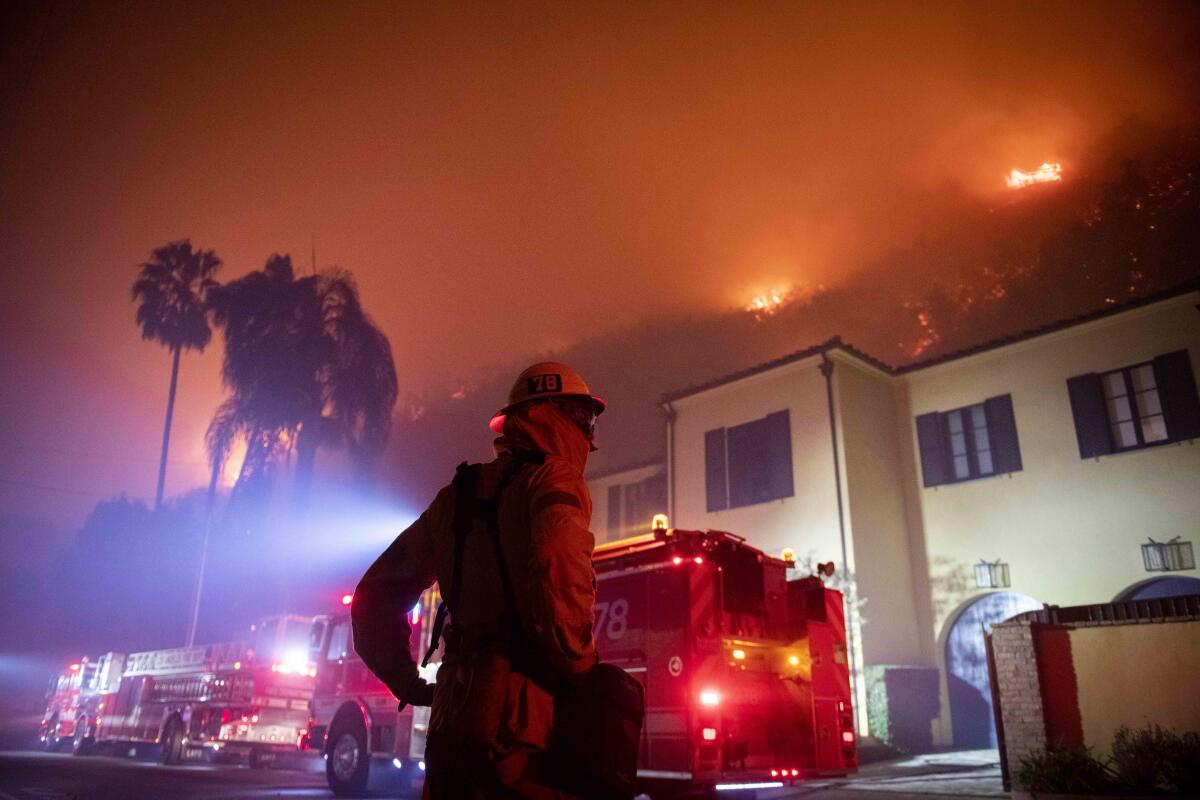
They put on masks and followed a road down the mountainside. Some students griped about having to evacuate while others were laughing “either because they didn’t know what was happening or as a coping mechanism,” Rodriguez said.
Rhonda Taylor got back to her Palisades home around 1 a.m. Monday and was getting ready for bed when she saw images of a fire on TV. Taylor assumed it was burning somewhere in the San Fernando Valley, and even if it was closer, she reasoned, the blaze that broke out in the Palisades last week hadn’t prompted an evacuation of her neighborhood.
She fell asleep but awoke around 3 a.m. to her phone ringing and the smell of smoke. Her throat was parched and her head hurt. She answered an L.A. County phone alert, telling her she needed to leave.
Although she already had what she calls her “apocalypse bag” in the car, Taylor was so nervous she grabbed extra toiletries, clothes and water. She put her Pomeranian, Bu, in his carrier, grabbed a 36-by-24-inch painting of her two children and swaddled it in pillowcases and loaded up her car.
As she drove to an evacuation center in Westwood, through smoke so thick it was like a deep fog descending on her neighborhood, Taylor cried, thinking of all the things she hadn’t had the time or the space in her car to gather up in the night.
She loves her house and the views it commands of the ocean. But she wonders whether it is worth living, as she puts it, “on the edge of fear.”
Robert Lempert, an expert on climate risk management and a Rand Corp. researcher, says there’s a growing awareness in his Palisades neighborhood that these large-scale fires aren’t anomalous. The Getty blaze and a smaller one in the Palisades last week are vivid demonstrations of this “new normal,” Lempert said.
“It’s one thing to look at the risk maps and show them to your family,” he said. “It’s another to get a knock on your door at 3 in the morning.”
Lempert and his neighbors have taken steps to mitigate a fire’s ability to blow through their streets, chiefly by removing dry brush that can become kindling for firebrands, which he described as “a wind-driven sea of matches.”
For their part, Lempert and his wife have cut down some trees on their property and trimmed back others, placed screens over their vents and installed metal skirts beneath their deck to shield it from embers.
“You see it slowly taking place,” Lempert said. “But the question is, are we doing it fast enough?”
The speed of the fire — whipped by strong Santa Ana winds — took many by surprise as they rushed to evacuate. As the flames licked closer, some were reminded of the Skirball fire, which was sparked by a cooking fire at a homeless encampment and tore through the region in 2017. The cause of the Getty fire is not yet known, fire officials said, but Garcetti said authorities had determined it was not sparked by homeless-encampment fires.
Several area schools will remain closed Wednesday due to fire conditions and evacuations.
Roberta Shintani and her son, Kevin, were woken at 3 a.m. by their roommate, who told them police had said they needed to go. Two years ago, when flames lashed the hillsides above the 405, Roberta and Kevin had prepared to evacuate but ultimately weren’t required to. This time, they had to go.
Roberta gathered clothes and her laptop, Kevin grabbed his guitar and, with their two dachshund mixes, Mowglie and Baloo, they made their way to an evacuation center in Westwood. The streets were choked with cars. Debris whipped through the air.
The sky, which was glowing orange when they woke up, “went from bright to extremely bright in a very short amount of time,” Kevin said.
Traffic nightmare on the 405
The fire caused a traffic mess on the 405 Freeway, one of the Southland’s main arteries. Shortly before 9 a.m., the California Highway Patrol announced the southbound lanes of the freeway were closed from the 101 Freeway to Sunset Boulevard. It was not clear when the freeway would reopen.
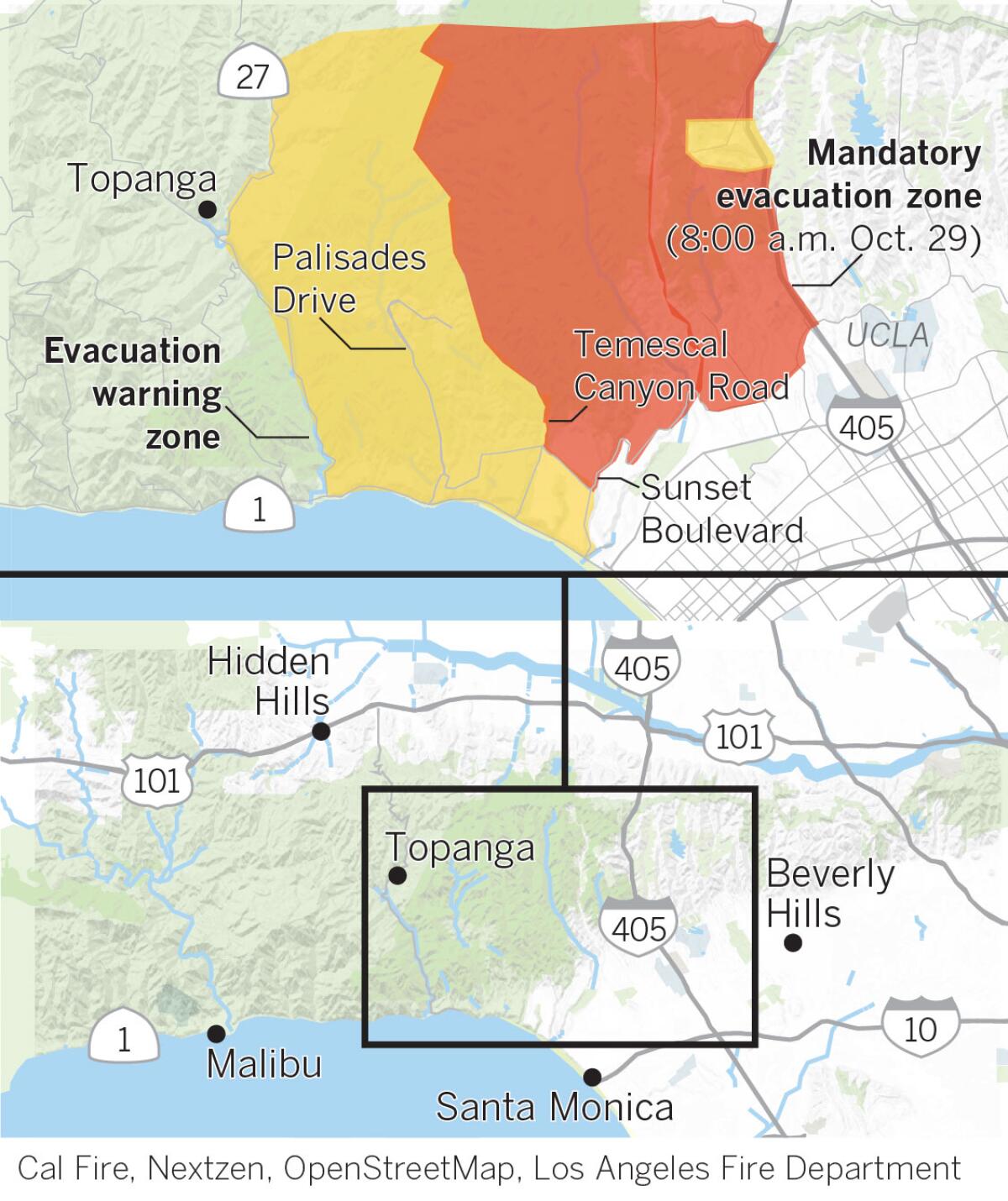
Gov. Gavin Newsom announced Monday that the state had secured a fire management assistance grant from the Federal Emergency Management Agency to help ensure the availability of resources to fight the Getty fire. The blaze erupted as firefighters were battling other large fires across the state, including the Tick fire in Santa Clarita and the Kincade fire in Sonoma County.
The Kincade fire exploded overnight from 54,000 acres to more than 66,200 acres and was just 5% contained as firefighters headed into the blaze’s fifth day. At least 96 structures have been destroyed, including 40 homes. No deaths have been reported.
The battle against that fire came as Pacific Gas & Electric Co. made the unprecedented decision to black out 940,000 residences and businesses, affecting millions of people from Bakersfield to Eureka, in an effort to prevent its electric lines from sparking new fires amid hurricane-force gusts.
“California is grateful for the ongoing support as we battle fires up and down the state in extremely severe weather conditions,” Newsom said. “I thank our heroic emergency responders and volunteers for their tireless, life-saving work to safeguard communities across the state.”
Times staff writers Alejandra Reyes-Velarde and Rong-Gong Lin II contributed to this report.
More to Read
Sign up for Essential California
The most important California stories and recommendations in your inbox every morning.
You may occasionally receive promotional content from the Los Angeles Times.


